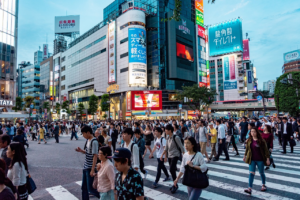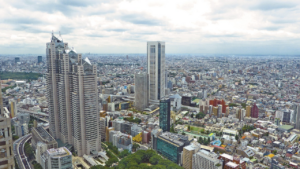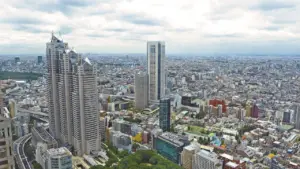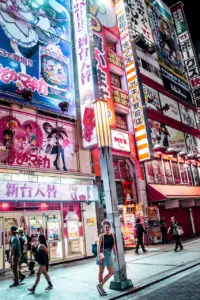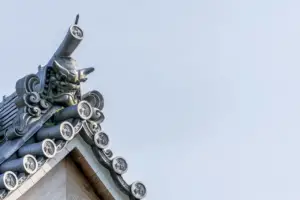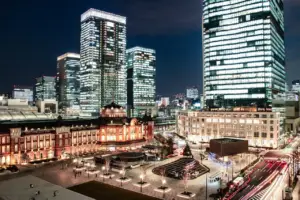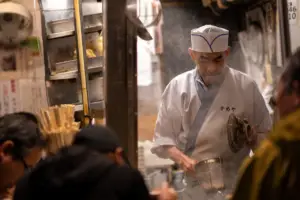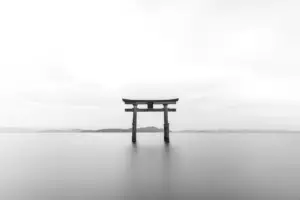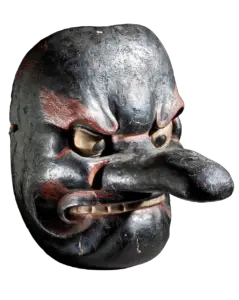Are you planning a trip to Tokyo and wondering which area to explore first? Look no further than Odaiba and Asakusa, two neighborhoods that offer vastly different experiences.
Odaiba is a modern entertainment district with futuristic architecture. In Odaiba, you can visit the iconic Rainbow Bridge, take a ride on the giant Ferris wheel, and shop at the futuristic VenusFort mall.
Asakusa, on the other hand, is known for its historic temples and shrines. Asakusa is home to the famous Sensoji Temple, Nakamise shopping street, and the Tokyo Skytree observation deck.
With such distinct offerings, it can be difficult to choose between the two. That’s why we’ve put together this ultimate showdown to help you decide which neighborhood to explore first.
Key Takeaways
- Odaiba is a modern, futuristic entertainment district with large shopping malls and unique attractions such as the Gundam statue and teamLab Borderless digital art museum.
- Asakusa is a neighborhood steeped in history and culture, with traditional shopping streets, famous temples and shrines, and a variety of restaurants serving classic Japanese dishes.
- Both Odaiba and Asakusa offer diverse dining options and vibrant nightlife, with Odaiba having numerous restaurants offering a wide range of cuisines and Asakusa being known for its traditional Japanese bars and Izakayas.
- Visitors to Tokyo should not miss out on both Odaiba and Asakusa for a well-rounded shopping and cultural experience, with Odaiba providing a modern and futuristic shopping experience and Asakusa offering a glimpse into traditional Japanese culture.
Overview of Odaiba and Asakusa
You’ll find yourself torn between the futuristic allure of Odaiba and the traditional charm of Asakusa.
Odaiba is an artificial island in Tokyo Bay that offers a modern and cutting-edge experience. It boasts some of Tokyo’s most iconic landmarks such as the Rainbow Bridge and the Gundam Statue. With various shopping centers, theme parks, and museums, Odaiba is a great destination for families and those who love technology and entertainment.
On the other hand, Asakusa is a neighborhood that is steeped in history and culture. It’s home to the famous Sensoji Temple, the oldest temple in Tokyo, and Nakamise-dori, a street lined with traditional shops and street food vendors. Asakusa offers a glimpse into the old Tokyo and is a great place to learn about Japan’s rich history and traditions.
With its narrow streets, old buildings, and nostalgic atmosphere, Asakusa is perfect for those who want to experience the traditional side of Tokyo.
Odaiba: Modern Entertainment and Futuristic Architecture
Are you ready for an adventure in modern entertainment and futuristic architecture? Odaiba has got you covered! Its iconic Rainbow Bridge and Gundam Statue are sure to catch your eye.
But the fun doesn’t stop there. You can also dip into the relaxing waters of Oedo Onsen Monogatari or immerse yourself in the interactive art exhibits at teamLab Borderless. And if you’re looking to shop and dine, Odaiba has a plethora of options to satisfy your cravings.
Rainbow Bridge and Gundam Statue
As you walk towards the Rainbow Bridge and Gundam Statue, you’ll feel the excitement building up inside you, knowing that you’re about to witness two of the most iconic landmarks of Odaiba.
The Rainbow Bridge, a suspension bridge that connects Shibaura Pier and Odaiba, stands out with its colorful lights at night, creating a stunning sight that will leave you in awe. The bridge is 798 meters long and has two decks, one for cars and the other for pedestrians and cyclists. As you cross the bridge, you can enjoy the panoramic view of Tokyo Bay and the city skyline.
The Gundam Statue, located at DiverCity Tokyo Plaza, is a must-see for anime fans. The statue stands at 18 meters tall and is a replica of the RX-0 Unicorn Gundam from the Mobile Suit Gundam Unicorn series. During the day, you can admire the intricate details of the statue’s armor, while at night, the statue transforms with a light and sound show.
You can take a closer look at the statue by visiting the Gundam Base Tokyo, where you can learn about the history of Gundam and purchase exclusive merchandise.
Don’t forget to bring your camera to capture the beauty of the Rainbow Bridge at night.
Be sure to check the schedule for the Gundam Statue’s light and sound show, as it only happens at specific times.
Take your time exploring the Gundam Base Tokyo, as there are many interesting exhibits and unique souvenirs to discover.
Oedo Onsen Monogatari and teamLab Borderless
Get ready to immerse yourself in a world of relaxation and wonder at Oedo Onsen Monogatari and teamLab Borderless.
Oedo Onsen Monogatari is a hot spring theme park that offers a unique onsen experience with a traditional Edo period setting. The park features a variety of indoor and outdoor baths, saunas, and relaxation areas. You can also enjoy traditional Japanese games and activities, such as goldfish scooping and yukata rental.
On the other hand, teamLab Borderless is an interactive art museum that offers a stunning digital art experience. The museum features various installations that combine art and technology to create a world of immersive and interactive experiences. You can explore the borderless world of art, where the boundaries between art and visitor are blurred.
Get ready to be amazed by the stunning visuals and the interactive nature of the exhibits.
Shopping and Dining
Indulge in some retail therapy and satisfy your taste buds with the diverse shopping and dining options in both Odaiba and Asakusa.
Odaiba boasts of its expansive shopping malls, such as the VenusFort, DiverCity Tokyo Plaza, and Aqua City Odaiba, which offer a wide range of brands and products. These malls cater to different budgets and preferences, from high-end fashion labels to affordable Japanese souvenirs. You can also find various restaurants and cafes that serve local and international cuisine, such as sushi, ramen, pizza, and burgers. Whether you want to have a quick bite or a fancy dinner, Odaiba has options for you.
On the other hand, Asakusa takes pride in its traditional shopping streets, such as Nakamise and Shin-Nakamise, where you can buy Japanese snacks, sweets, and souvenirs. These streets are lined with small shops that sell items like fans, lanterns, and traditional clothing. Asakusa also offers a variety of restaurants that serve classic Japanese dishes like tempura, udon, and soba. You can also enjoy street food like takoyaki and yakitori from the food stalls in the area.
Whether you prefer modern or traditional shopping and dining experiences, Odaiba and Asakusa have something to offer.
Asakusa: Historic Temples and Shrines
You’ll be transported back in time as you wander through the ancient temples and shrines of Asakusa.
One of the most famous landmarks in the area is the Sensoji Temple, which dates back to the 7th century. The temple complex includes a five-story pagoda, as well as numerous smaller shrines and shops selling traditional goods and souvenirs. Don’t forget to try some of the local snacks like sweet rice crackers or fried manju while you’re there.
Another must-visit spot in Asakusa is the Asakusa Shrine, which is dedicated to three Shinto gods. The shrine is particularly beautiful during the annual Sanja Festival, which takes place in May and features spectacular parades with traditional costumes and music.
If you’re interested in learning more about the history of the area, consider visiting the Edo-Tokyo Museum, which showcases the culture and lifestyle of the city during the Edo period.
With its rich cultural heritage and fascinating landmarks, Asakusa is a true gem that’s not to be missed.
Transportation and Accessibility
Now that you have learned about the historic temples and shrines in Asakusa, let’s talk about transportation and accessibility in the area. Asakusa is a popular tourist destination, so it’s important to know how to get there and how to get around once you’re there.
Luckily, Asakusa is easily accessible by public transportation. The area is served by multiple train and subway lines, making it convenient to reach from other parts of Tokyo. Additionally, there are several bus routes that stop in Asakusa. Once you arrive, walking is the easiest way to get around. The main attractions, such as Sensoji Temple and Nakamise shopping street, are all within walking distance of each other. To help you navigate your way around Asakusa, take a look at this table of transportation options:
| Transportation | Description | Estimated Cost |
|---|---|---|
| Train | Multiple train lines serve Asakusa, including the Ginza Line, Asakusa Line, and Tobu Skytree Line. | ¥200-¥400 |
| Subway | The Tokyo Metro Ginza Line and Toei Asakusa Line both stop in Asakusa. | ¥200-¥400 |
| Bus | Several bus routes stop in Asakusa, including the Toei Asakusa Line and the Tobu Tourist Bus. | ¥200-¥300 |
| Walking | The main attractions in Asakusa are all within walking distance of each other. | Free |
| Taxi | Taxis are available in Asakusa, but can be expensive. | Starting at ¥730 |
As you can see, there are plenty of transportation options for getting to and around Asakusa. By using this table as a guide, you can plan your transportation ahead of time and make the most out of your visit to this historic area.
Accommodations
Looking for a place to stay in Tokyo? Whether you prefer the futuristic vibe of Odaiba or the traditional charm of Asakusa, there are plenty of hotels and hostels to choose from in both areas.
From luxurious high-rise hotels to cozy backpacker hostels, you’ll find options to fit any budget.
So, why not take a closer look at the accommodations available in these two popular neighborhoods?
Hotels and Hostels in Odaiba
If you’re planning to stay in Odaiba, there’s no shortage of hotels and hostels to choose from, each offering breathtaking views of Tokyo Bay.
Here are some top options to consider:
-
Hilton Tokyo Odaiba: This luxurious hotel offers spacious rooms with floor-to-ceiling windows and stunning bay views. It also has a rooftop bar and a pool overlooking the city.
-
Grand Nikko Tokyo Daiba: This elegant hotel features Japanese-style rooms, a large indoor pool, and a fitness center. It’s located right next to the Odaiba Seaside Park and offers easy access to nearby attractions.
-
Capsule Hotel & Sauna Cosmo: For a budget-friendly option, this capsule hotel provides a unique experience with individual sleeping capsules and a communal sauna. It also has a restaurant and lounge area for guests to relax.
-
Oakwood Apartments Tokyo: If you prefer a more homey feel, these serviced apartments offer fully equipped kitchens and laundry facilities. They are located in a quiet area of Odaiba, but still within walking distance to shops and restaurants.
No matter which accommodation you choose in Odaiba, you’ll be sure to have a comfortable and memorable stay.
Hotels and Hostels in Asakusa
When planning a trip to Tokyo, you’ll want to consider staying in Asakusa, where there are plenty of hotels and hostels to choose from. Asakusa is a popular tourist destination known for its ancient temples, bustling streets, and vibrant culture.
Whether you’re traveling solo or with a group, there is an accommodation option to suit your needs and budget. One of the most popular hotels in Asakusa is the Asakusa View Hotel. This hotel offers stunning views of Tokyo Skytree and is situated just a few minutes away from both the Senso-ji Temple and the Asakusa Shrine. The hotel has a variety of room types to choose from, including traditional Japanese-style rooms and Western-style rooms. Other amenities include an on-site restaurant, a fitness center, and a rooftop terrace.
Another great option for budget travelers is the Khaosan Tokyo Kabuki Hostel. This hostel offers dormitory-style rooms and private rooms, and is located just a short walk away from the famous Kaminarimon Gate. The hostel also offers a variety of activities, such as sake tastings and cultural workshops, to help guests immerse themselves in the local culture.
Budget-Friendly Options
As you’ve learned, Asakusa has an array of hotels and hostels to choose from. But what if you’re on a tight budget? Don’t worry, there are still plenty of options for you.
Let’s take a look at some budget-friendly accommodations in Asakusa.
First up, we have Khaosan Tokyo Kabuki Hostel. This hostel offers dormitory-style rooms at a very affordable price, making it a great option for solo travelers or those on a tight budget. The hostel is located just a 5-minute walk from Asakusa Station and is in close proximity to many of Asakusa’s top attractions, such as Sensoji Temple and Nakamise Shopping Street.
The hostel also offers a communal kitchen and lounge area for guests to use, as well as free Wi-Fi throughout the building. Overall, Khaosan Tokyo Kabuki Hostel is a great choice for those looking for a budget-friendly stay in Asakusa.
Dining and Nightlife
You’ll love the diverse dining options and vibrant nightlife in both Odaiba and Asakusa.
In Odaiba, there are numerous restaurants that offer a wide range of cuisines including Japanese, Italian, Korean, and more. You can enjoy a delicious seafood meal at one of the many seafood restaurants or try some of the local specialties like Takoyaki and Okonomiyaki. Don’t forget to check out the food courts in the various shopping centers where you can find affordable yet tasty meals.
When it comes to nightlife, Odaiba has something for everyone. You can enjoy a drink at one of the many bars with stunning views of Tokyo Bay or dance the night away at one of the clubs. There are also many entertainment options like karaoke and game centers.
Asakusa is also known for its nightlife, especially the traditional Japanese bars and Izakayas. You can also find many night markets selling street food and souvenirs.
Overall, both Odaiba and Asakusa offer a unique experience when it comes to dining and nightlife, and you won’t be disappointed.
Shopping
Explore the bustling streets and colorful shops of both Odaiba and Asakusa to find unique souvenirs, fashionable clothes, and traditional Japanese crafts and snacks.
In Odaiba, you can find shopping malls like Venus Fort and Aqua City, which offer a variety of shops ranging from international brands to local designers. You can also visit the Gundam Base Tokyo, where you can buy figurines and other merchandise related to the popular anime series.
Meanwhile, in Asakusa, you can stroll down Nakamise-dori, a street filled with souvenir shops selling traditional Japanese items like fans, yukatas, and folding screens. You can also visit the Asakusa ROX shopping center, which offers a mix of international brands and local designers.
Don’t forget to stop by the popular Senso-ji temple, where you can find a variety of traditional Japanese snacks and treats to take home as souvenirs. With so many options to choose from, both Odaiba and Asakusa offer a unique shopping experience that’s sure to satisfy any traveler.
Final Verdict and Recommendations
In conclusion, visitors to Tokyo should definitely take the time to check out both Odaiba and Asakusa for a well-rounded shopping and cultural experience.
Odaiba offers a modern and futuristic shopping experience, with its large malls and unique attractions like the Gundam statue and the digital art museum teamLab Borderless. It’s also a great place to enjoy the waterfront views and take a leisurely stroll along the Rainbow Bridge.
On the other hand, Asakusa provides a glimpse into traditional Japanese culture, with its historic streets and famous Sensoji Temple. The area is known for its traditional crafts and souvenirs, such as handmade fans and wooden dolls, as well as its delicious street food like senbei rice crackers and sweet potato skewers.
Overall, both Odaiba and Asakusa have their own unique charm and should not be missed when visiting Tokyo.
Frequently Asked Questions
What is the history behind the rivalry between Odaiba and Asakusa?
To understand the rivalry between Odaiba and Asakusa, you need to look back at their histories.
Asakusa is home to the historic Senso-ji temple, which has been a center of worship for over 1,300 years.
On the other hand, Odaiba was once a group of small islands that were reclaimed in the 20th century and transformed into a modern entertainment district.
The two areas have vastly different vibes, with Asakusa retaining its traditional Japanese atmosphere and Odaiba embracing futuristic technology and entertainment.
This contrast has fueled the rivalry between the two, with each area vying for the attention and admiration of tourists and locals alike.
While both have their unique charms, it ultimately comes down to personal preference when it comes to choosing which one to visit.
Are there any hidden gems or lesser-known attractions in Odaiba or Asakusa that are worth visiting?
If you’re looking for hidden gems in Odaiba or Asakusa, there are definitely a few worth checking out.
In Odaiba, you might want to visit the Miraikan museum for an interactive science experience, or the Oedo Onsen Monogatari for a traditional Japanese hot spring experience.
As for Asakusa, there’s the lesser-known Hanayashiki amusement park, which is the oldest in Japan and has a retro charm, or the Sumida Hokusai Museum for a glimpse into the life and work of the famous artist.
No matter which neighborhood you choose to explore, there are plenty of unique and interesting attractions to discover beyond the usual tourist hotspots.
How do the prices of accommodations, dining, and shopping in Odaiba and Asakusa compare to other areas in Tokyo?
When it comes to accommodations, dining, and shopping, both Odaiba and Asakusa offer a range of options at varying price points.
In terms of accommodations, Asakusa has a higher concentration of traditional Japanese inns and budget-friendly capsule hotels, while Odaiba has more luxury hotels with waterfront views.
Dining options in both areas range from affordable street food to high-end restaurants, with Asakusa being known for its traditional Japanese cuisine and Odaiba offering a mix of international cuisine.
Shopping in Odaiba tends to be more focused on high-end brands and electronics, while Asakusa offers a bustling shopping street with traditional souvenirs and goods.
Overall, prices in both areas can be higher than other parts of Tokyo, but there are still plenty of options for those on a budget.
Are there any cultural events or festivals that take place in Odaiba or Asakusa throughout the year?
If you’re looking for cultural events and festivals in Tokyo, both Odaiba and Asakusa have plenty to offer throughout the year.
In Odaiba, you can experience traditional Japanese festivals like the Odaiba Lantern Festival in August and the Odaiba Hawaii Festival in July. The latter celebrates Hawaiian culture with hula dancing, live music, and food.
Asakusa, on the other hand, is known for its famous festivals like the Sanja Matsuri in May. Millions of people gather to watch the parade of portable shrines and traditional costumes. There’s also the Asakusa Samba Carnival in August, which features colorful floats and samba dancers.
No matter which area you choose, you’re sure to find cultural events and festivals that will immerse you in the rich traditions of Japan.
What are some recommended activities or experiences for families with young children in Odaiba or Asakusa?
If you’re looking for fun activities for families with young children in Odaiba or Asakusa, there are plenty of options.
In Odaiba, you can visit the Legoland Discovery Center or the Tokyo Joypolis indoor theme park. Take a ride on the giant Ferris wheel or enjoy the beach at Odaiba Seaside Park.
As for Asakusa, a visit to the Sensoji Temple is a must-see. You can also take a boat ride along the Sumida River or explore the traditional shopping street of Nakamise. For a unique experience, try dressing up in traditional Japanese clothing and taking photos at one of the many rental shops in the area.
Both Odaiba and Asakusa offer plenty of fun and engaging activities for families with young children to enjoy.
Conclusion
So, which is the ultimate destination for your Tokyo trip: Odaiba or Asakusa? Both have their unique charms and attractions, and ultimately it comes down to your personal preferences.
If you’re looking for a modern and trendy atmosphere with plenty of entertainment options, Odaiba is the place to be. On the other hand, if you’re interested in immersing yourself in traditional Japanese culture and history, Asakusa is the perfect choice.
Regardless of which destination you choose, Tokyo is sure to offer you a memorable experience. So why not visit both and decide for yourself which one you prefer?
With easy transportation and plenty of accommodations, dining, and shopping options, your trip to Tokyo is sure to be an unforgettable one.






















